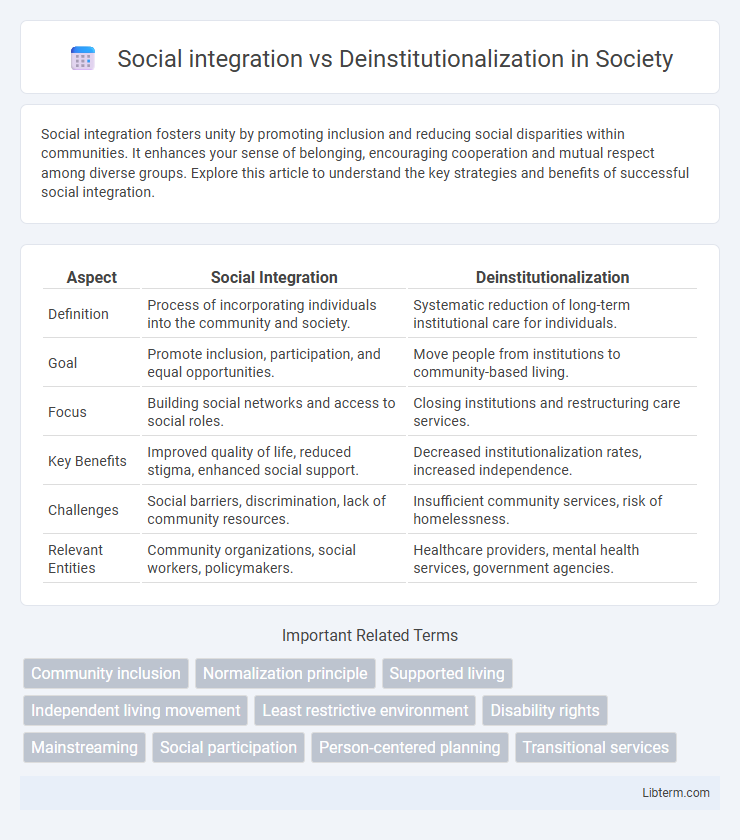Social integration fosters unity by promoting inclusion and reducing social disparities within communities. It enhances your sense of belonging, encouraging cooperation and mutual respect among diverse groups. Explore this article to understand the key strategies and benefits of successful social integration.
Table of Comparison
| Aspect | Social Integration | Deinstitutionalization |
|---|---|---|
| Definition | Process of incorporating individuals into the community and society. | Systematic reduction of long-term institutional care for individuals. |
| Goal | Promote inclusion, participation, and equal opportunities. | Move people from institutions to community-based living. |
| Focus | Building social networks and access to social roles. | Closing institutions and restructuring care services. |
| Key Benefits | Improved quality of life, reduced stigma, enhanced social support. | Decreased institutionalization rates, increased independence. |
| Challenges | Social barriers, discrimination, lack of community resources. | Insufficient community services, risk of homelessness. |
| Relevant Entities | Community organizations, social workers, policymakers. | Healthcare providers, mental health services, government agencies. |
Understanding Social Integration
Understanding social integration involves promoting full participation of individuals with mental health conditions in community life through access to housing, employment, and social networks. It emphasizes personalized support systems and inclusive policies that foster belonging and reduce stigma. Effective social integration supports recovery by enhancing self-esteem and independence, contrasting with deinstitutionalization's shift away from long-term psychiatric hospitalization without always ensuring adequate community resources.
Defining Deinstitutionalization
Deinstitutionalization refers to the systematic process of reducing reliance on large psychiatric hospitals by relocating individuals with mental illnesses into community-based settings. This approach aims to promote social integration by providing support services that facilitate independent living and social participation. Effective deinstitutionalization requires coordinated healthcare, housing, and social services to ensure seamless transitions and reduce hospitalization rates.
Historical Context and Evolution
Social integration and deinstitutionalization emerged as pivotal responses to mental health care reform throughout the 20th century. Deinstitutionalization began in the 1950s driven by advances in psychiatric medication and civil rights movements, leading to mass closures of psychiatric hospitals. This shift prioritized community-based services, fostering social integration by promoting inclusion and support within normal living environments for individuals with mental illness.
Key Differences Between Social Integration and Deinstitutionalization
Social integration emphasizes the inclusion and active participation of individuals with disabilities or mental health conditions in community life, fostering social networks and support systems. Deinstitutionalization involves the systematic closure of large psychiatric hospitals and the relocation of patients to community-based care settings. The key difference lies in social integration's focus on enhancing quality of life through societal engagement, whereas deinstitutionalization centers on shifting care delivery from institutional to community environments.
Benefits of Social Integration
Social integration fosters community engagement, enhancing mental health and reducing isolation for individuals with disabilities or mental illnesses. It supports personalized care through inclusive environments, promoting independence and social skills development. Access to diverse social networks and employment opportunities further improves quality of life and societal participation.
Challenges of Deinstitutionalization
Deinstitutionalization faces significant challenges such as inadequate community-based services, leading to homelessness and increased incarceration rates among formerly institutionalized individuals. Social integration efforts struggle due to stigma, limited housing options, and insufficient mental health support systems. These obstacles hinder the successful transition and long-term stability of individuals moving from psychiatric institutions to community settings.
Impact on Individuals with Disabilities
Social integration promotes community participation and access to resources for individuals with disabilities, enhancing their quality of life and independence. Deinstitutionalization seeks to move people from large, isolated institutions into community-based settings, reducing stigma and improving personal autonomy. Both approaches emphasize individualized support but require comprehensive services to address challenges such as social isolation and access to healthcare.
Community Involvement and Support Systems
Strong social integration relies on robust community involvement and well-established support systems that promote inclusion and reduce isolation for individuals transitioning from institutional care. Deinstitutionalization emphasizes moving individuals into community-based settings where access to local resources, peer networks, and supportive services fosters personal autonomy and social participation. Effective support systems, including mental health services, housing assistance, and vocational programs, are crucial for sustaining community integration and improving overall quality of life.
Policy Approaches and Global Perspectives
Social integration policies emphasize community-based support and inclusive services to enhance individuals' participation in society, promoting autonomy and reducing stigma. Deinstitutionalization involves relocating individuals from psychiatric or social institutions to less restrictive community settings, aiming to improve quality of life while posing challenges in resource allocation and care continuity. Globally, policy approaches vary widely; high-income countries adopt structured deinstitutionalization with robust social integration frameworks, whereas low and middle-income countries face implementation hurdles due to limited infrastructure and funding.
Future Directions for Inclusive Societies
Future directions for inclusive societies emphasize the coexistence of social integration and deinstitutionalization, promoting community-based supports that respect individual autonomy. Advancements in assistive technologies and personalized care models facilitate greater participation of marginalized groups in social, educational, and employment settings. Policy frameworks must prioritize accessible infrastructure and anti-discrimination laws to sustain inclusive environments beyond institutional care.
Social integration Infographic

 libterm.com
libterm.com